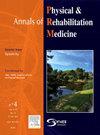中重度创伤性脑损伤后感觉改变的发生率及临床意义:一项横断面研究
IF 4.6
3区 医学
Q1 REHABILITATION
Annals of Physical and Rehabilitation Medicine
Pub Date : 2025-05-09
DOI:10.1016/j.rehab.2025.101993
引用次数: 0
摘要
背景:感觉改变在中重度创伤性脑损伤(msTBI)患者中很常见,但仍未得到充分研究。目的探讨msTBI后感觉改变的普遍性及其与情绪困扰、功能障碍和生活满意度的关系。方法对387例msTBI患者进行横断面调查(伤后平均年数12.8;范围= 0.4-35.0岁)和60名对照组,年龄和性别不匹配,但在同一时期招募。使用自定义检查表和躯体症状量表-8 (SSS-8)评估自我报告的感觉症状。采用医院焦虑抑郁量表(HADS)、12项世界卫生组织残疾评估表2.0 (WHODAS 2.0)和生活满意度量表(SWLS)测量情绪困扰、功能残疾和生活满意度。我们比较了各组之间感觉症状的频率,并检查了msTBI样本中与人口统计学、损伤因素和临床结果的关联。结果70%的msTBI患者报告因脑损伤而出现≥1种感觉改变,35%的患者报告在前一周出现头晕,平均总共出现2.2种症状,在调整年龄和性别后显著高于对照组。感觉变化在年轻参与者(光过敏)、女性(光和噪音过敏)、更严重的TBI患者(整体感觉变化、视力受影响、嗅觉减退)和损伤后较短时间的患者(整体感觉变化、噪音过敏、嗅觉减退、味觉改变、头晕)中更为常见,尽管许多这些关联在多次比较校正后都无法存活。感觉变化明显且一致地与较差的临床结果相关,对情绪困扰和功能残疾的影响为中大型,对生活满意度的影响较小。结论:虽然不能确定因果关系,但这些发现表明,msTBI后的感觉变化是一个重要的临床问题,即使是在平均受伤后10年以上的个体中也是如此。这强调了对潜在机制和干预措施进行常规评估和进一步研究的必要性。本文章由计算机程序翻译,如有差异,请以英文原文为准。
Prevalence and clinical significance of sensory changes after moderate-severe traumatic brain injury: A cross-sectional study
Background
Sensory changes are commonly observed in individuals with moderate-severe traumatic brain injury (msTBI) but remain under-researched.
Objectives
This study examined the prevalence of sensory changes after msTBI and relationships with emotional distress, functional disability, and life satisfaction.
Methods
A cross-sectional survey was conducted including 387 participants with msTBI (mean years post-injury, 12.8; range = 0.4–35.0 years) and 60 controls, not matched on age and sex but recruited in the same period. Self-reported sensory symptoms were assessed using a custom checklist and the Somatic Symptom Scale–8 (SSS-8). Emotional distress, functional disability, and life satisfaction were measured through the Hospital Anxiety and Depression Scale (HADS), 12-Item World Health Organization Disability Assessment Schedule 2.0 (WHODAS 2.0), and Satisfaction With Life Scale (SWLS). We compared the frequency of sensory symptoms between groups and examined associations with demographics, injury factors, and clinical outcomes within the msTBI sample.
Results
70% with msTBI reported experiencing ≥1 sensory changes due to their brain injury, and 35% reported experiencing dizziness in the previous week, averaging 2.2 symptoms in total, which was significantly higher than controls after adjusting for age and sex. Sensory changes were more common in younger participants (light hypersensitivity), females (light and noise hypersensitivity), those with more severe TBI (overall sensory changes, affected vision, reduced smell), and those fewer years post-injury (overall sensory changes, noise hypersensitivity, reduced smell, altered taste, dizziness), though many of these associations did not survive multiple comparison correction. Sensory changes were clearly and consistently associated with worse clinical outcomes, with medium-large effect sizes for emotional distress and functional disability and smaller effects for life satisfaction.
Conclusions
Although causality cannot be established, these findings suggest that sensory changes are a clinically significant issue after msTBI, even among individuals more than a decade post-injury on average. This underscores the need for routine assessment and further research on underlying mechanisms and interventions.
求助全文
通过发布文献求助,成功后即可免费获取论文全文。
去求助
来源期刊

Annals of Physical and Rehabilitation Medicine
Medicine-Rehabilitation
CiteScore
7.80
自引率
4.30%
发文量
136
审稿时长
34 days
期刊介绍:
Annals of Physical and Rehabilitation Medicine covers all areas of Rehabilitation and Physical Medicine; such as: methods of evaluation of motor, sensory, cognitive and visceral impairments; acute and chronic musculoskeletal disorders and pain; disabilities in adult and children ; processes of rehabilitation in orthopaedic, rhumatological, neurological, cardiovascular, pulmonary and urological diseases.
 求助内容:
求助内容: 应助结果提醒方式:
应助结果提醒方式:


